Mark Rothko Blue Green and Brown What Was It Sold for
Mark Rothko, Untitled (Seagram Mural sketch), 1959, oil and mixed media on canvas, Gift of The Mark Rothko Foundation, Inc., 1986.43.156
Here Rothko turned to a palette of red, maroon, brown, and black. The artist eventually withdrew from this project, due to misgivings about the restaurant as a proper setting for his work. He had, however, already produced a number of studies and finished canvases, two of which are included in the present installation.
Mark Rothko, No. 4, 1964, mixed media on canvas, Gift of The Mark Rothko Foundation, Inc., 1986.43.152
With some exceptions, the darkened palette continued to dominate Rothko's work well into the 1960s. He developed a painstaking technique of overlaying colors until, in the words of art historian Dore Ashton, "his surfaces were velvety as poems of the night."
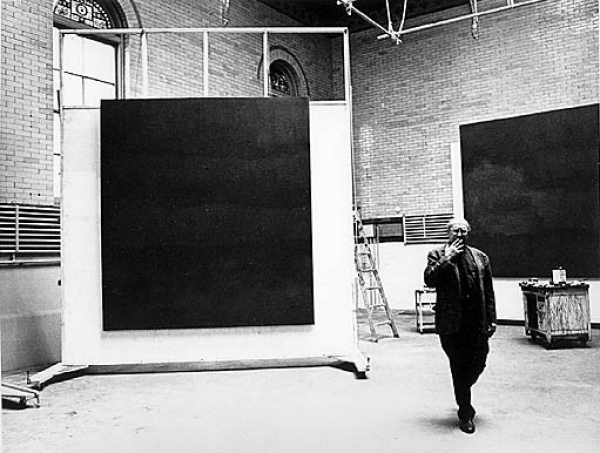
Rothko in his 69th Street studio with Rothko Chapel murals, c. 1964, © Hans Namuth Estate, courtesy Center for Creative Photography, The University of Arizona
His work on the Rothko Chapel paintings, originally commissioned by John and Dominique de Menil for the University of St. Thomas in Houston, Texas, occupied Rothko between 1964 and 1967. In turning away from the radiance of the previous decade, Rothko heightened the perceptual subtlety of his paintings, making distinctions between shape and ground more difficult to discern. He also transformed the impact his canvases have on the experience of space, which is now characterized by a sensation of enclosure. This quality, which lends itself to meditation, can be clearly related to the spiritual nature of a chapel.
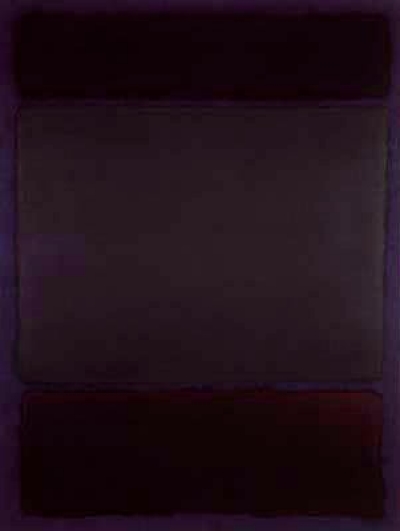
Mark Rothko, Untitled, 1968, Private Collection
Rothko's reading of Nietzsche, the 19th-century German philosopher, suggests that his work could represent the opposition between a rational or abstract element and an emotional, primal, or tragic one (referring to Nietzsche's discussion of the polarity between an Apollonian and a Dionysian principle). Certain qualities, such as radiance or the duality of light and dark, have a symbolic meaning in Western culture from which Rothko clearly drew. An impression of vast space is said to represent the historical concept of the "sublime," a quasi-religious experience of limitless immensity. The installation of these canvases also produces its own sacrosanct environment.
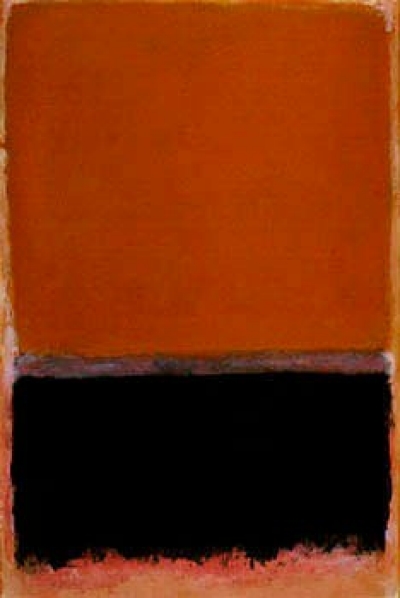
Mark Rothko,Untitled, 1953, Private Collection
At different times during the 1950s and 1960s, Rothko produced a substantial quantity of small works on paper. It is not certain whether these are studies for larger paintings or simply smaller variations employing a similar dynamic of form and color. Rothko had many of them mounted on panel, canvas, or board in order to simulate the presence of unframed canvases. The smaller format especially suited Rothko in 1968, when his physical activity was dramatically curtailed by a heart ailment. Rothko continued to work predominantly on paper even after he returned to a relatively large format in 1969.
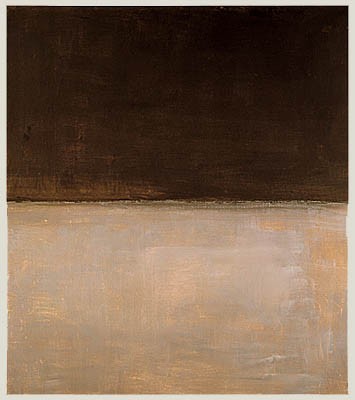
Mark Rothko, Untitled, 1969, John and Mary Pappajohn, Des Moines, Iowa
In a series of brown- or black-and-gray paintings produced from 1969 to 1970, Rothko divided the composition horizontally and framed the image with a white margin (created by masking the edges of the paper or canvas with tape that was later removed to expose the bare support). The serene dark zone stands out against the turbulent brushwork of the gray section, an area further modulated by the addition of ochre or blue. The sharply defined edge establishes a complex interplay between the work and the viewer, who is drawn into the painting by its sensuous surface, yet kept at a distance by the stark framing device.
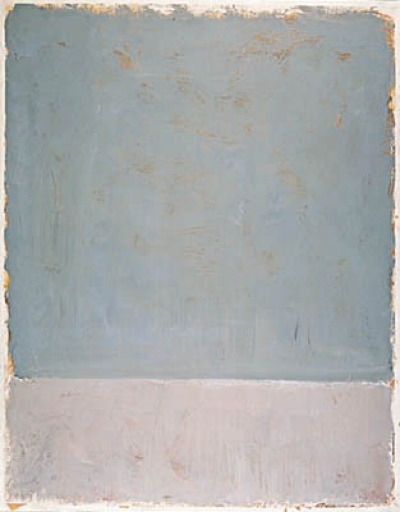
Mark Rothko, Untitled, 1969, Collection of Kate Rothko Prizel
In another series from this period, Rothko used a softer range of pink and blue for compositions that sometimes recall smaller works from the mid-1940s. A certain ascetic quality suggests that Rothko had embarked on a new direction, one which may have been related to the reductive work of younger artists at that time. Unlike the minimalists, however, Rothko never abandoned his conviction in the ability of abstract art to be experienced in emotionally expressive terms.
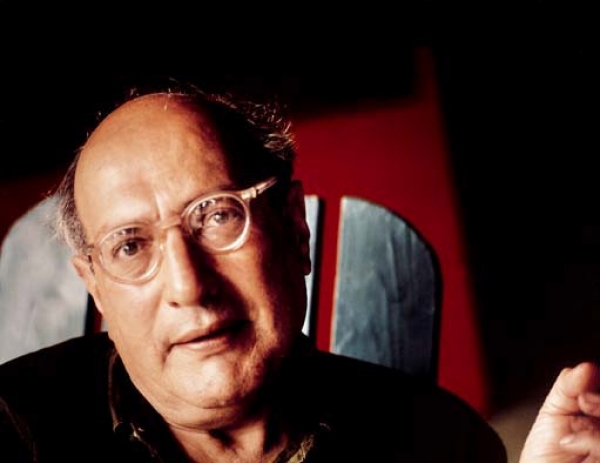
Mark Rothko in his studio, c. 1964, © Hans Namuth Estate, courtesy Center for Creative Photography, The University of Arizona (provided by Archives of American Art, Hans Namuth Photographs and Papers)
Physically ill and suffering from depression, Rothko committed suicide on February 25, 1970. At the time of his death, he was widely recognized in Europe and America for his crucial role in the development of nonrepresentational art. His vibrant, disembodied veils of color asserted the power of nonobjective painting to convey strong emotional or spiritual content. With an unwavering commitment to a singular artistic vision, Rothko celebrated the near-mythic power art holds over the creative imagination.
This web feature originally was produced in conjunction with the exhibition Mark Rothko, on view at the National Gallery of Art from May 3 to August 16, 1998. Sponsored by Mobil. The exhibition traveled to the Whitney Museum of American Art, New York, September 17–November 29, 1998, and to the Musée d'Art Moderne de la Ville de Paris, January 14–April 18, 1999.
The following notice appears at the request of the artist's heirs: Works by Mark Rothko © 1998 Christopher Rothko and Kate Rothko Prizel.
Exhibition Credits (1998)
Curator:
Jeffrey Weiss, associate curator, 20th-century art, National Gallery of Art. Consultants for the exhibition are Mark Rosenthal, curator of 20th-century art, Solomon R. Guggenheim Museum, New York, and David Anfam, author of the forthcoming Rothko catalogue raisonné.Publication: A fully illustrated catalog has been copublished by the National Gallery of Art and Yale University Press, with contributions from John Gage, Carol Mancusi-Ungaro, Barbara Novak, Brian O'Doherty, Mark Rosenthal, Jessica Stewart, and Jeffrey Weiss. It also includes interviews with Ellsworth Kelly, Brice Marden, Gerhard Richter, Robert Ryman, and George Segal about Rothko's artistic legacy.
Organization: The exhibition has been organized by the National Gallery of Art.
Sponsor: The exhibition is sponsored by Mobil.
Schedule: National Gallery of Art, May 3–August 16, 1998; Whitney Museum of American Art, September 17–November 29, 1998; Musée d'Art Moderne de la Ville de Paris, January 8–April 18, 1999
Works by Mark Rothko in the National Gallery's Permanent Collection
The National Gallery of Art maintains the largest public collection of art by the American artist Mark Rothko (1903–1970). In 1986 the Mark Rothko Foundation determined that its mission to conserve its collection of Rothko's art and to enhance and promote the artist's legacy through scholarly research and exhibitions would be best served by strategically placing his canvases and works on paper in selected major international museums. Before disbanding in the same year, the Foundation designated 35 institutions to receive the art. As the principal recipient of the Mark Rothko Foundation's largesse, the National Gallery of Art received more than 1,100 works—paintings on canvas and works on paper—as well as research materials, including conservation records and exhibition reviews.
View a complete list of works by
williamsoncoveress.blogspot.com
Source: https://www.nga.gov/features/mark-rothko/mark-rothko-classic-paintings.html


0 Response to "Mark Rothko Blue Green and Brown What Was It Sold for"
Post a Comment